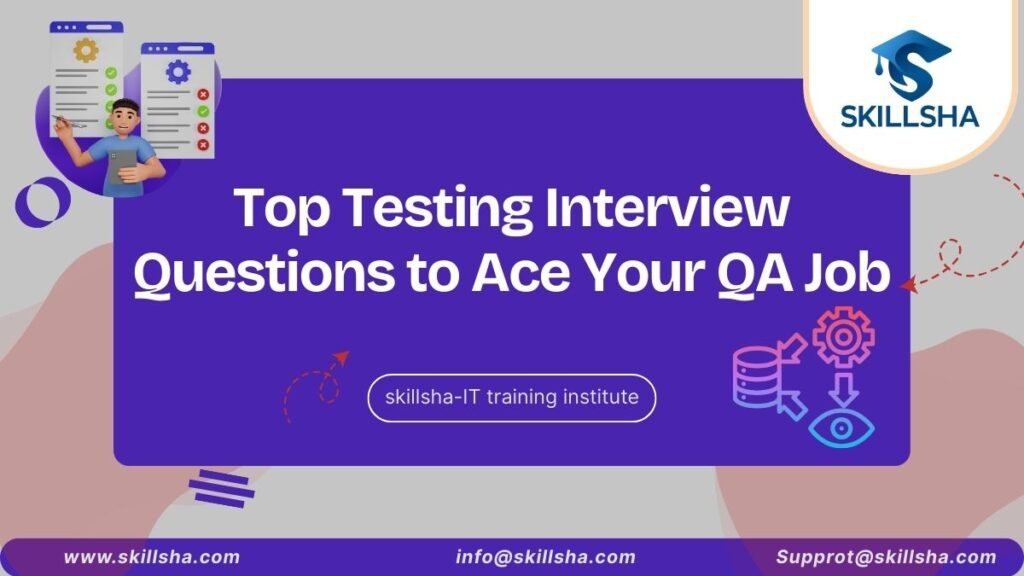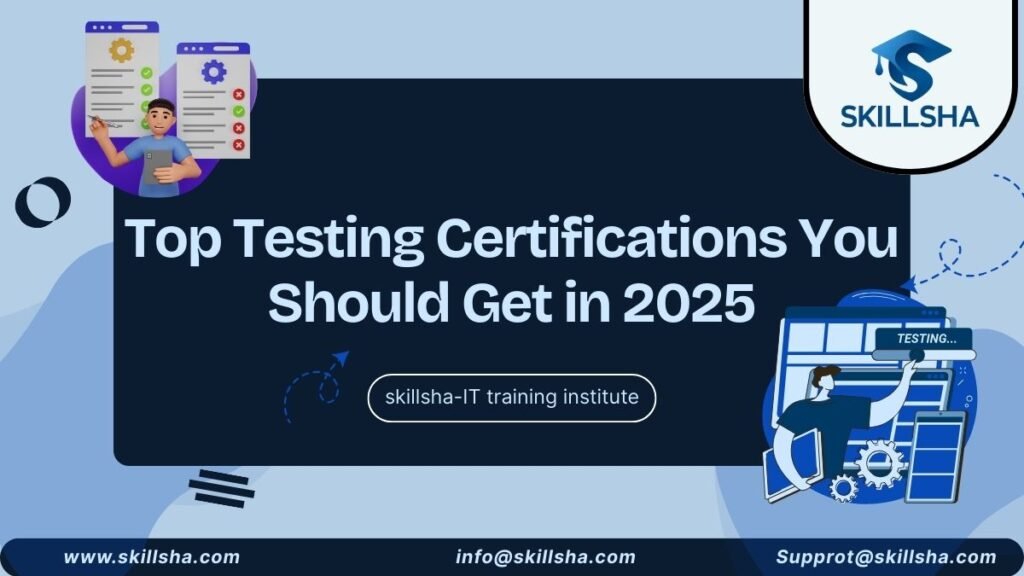Let’s cut to the chase: if you’re walking into a testing interview in 2025, you’d better be sharp. Interviewers aren’t just tossing trivia at you. They want to see how you think, how you solve problems, and whether you can apply what you know in real-world situations.
This guide isn’t just a list of questions. It’s a breakdown of what matters, why it gets asked, and how you can answer like someone who actually understands testing. We’ll cover manual testing, automation, API, Agile, DB testing, and scenario-based stuff. And yes, if you’re learning this through Skillsha, you’re already in the right place.
Let’s break it down.
Manual Testing Questions That Still Matter
1. What’s the difference between verification and validation?
They sound similar but aren’t. Verification checks if the product is being built right (are we following the spec?). Validation checks if we’re building the right product (does it meet user needs?).
2. What’s the role of a test case?
Test cases give structure to your testing. A test case isn’t just a checklist — it’s proof of coverage. It tells the story of how something was tested, what was expected, and what actually happened.
3. What’s the difference between severity and priority?
Severity is about the impact of the bug. Priority is about when it should be fixed. A typo in a logo is low severity but might be high priority if it’s on a client-facing app.
4. How do you handle incomplete or unclear requirements?
Talk to the stakeholders. Ask clarifying questions. Define assumptions. And always document what you’re testing against. At Skillsha, we drill this through real-world examples.
5. What’s exploratory testing?
Unscripted, smart testing. You explore the app with intent, looking for issues while learning how it behaves. It’s not random clicking — it’s guided discovery.
Automation Testing Questions You’ll Hear Often
6. What’s the main difference between Selenium and Cypress?
Selenium is browser-agnostic and language-flexible. Cypress is fast, modern, but tied to JavaScript and Chrome-based browsers. At Skillsha, we make sure you’ve used both so you can speak from experience.
7. What are locators in Selenium?
They’re how you find elements. ID, className, name, XPath, CSS selectors. XPath is powerful but messy. CSS is cleaner if you can use it.
8. What’s a test framework? Why use one?
A framework organizes your test code. Think TestNG, JUnit, or Pytest. It handles test structure, setup/teardown, data, and reports.
9. What’s Page Object Model (POM)?
It’s a design pattern. You separate test logic from UI interactions. This makes your code clean, reusable, and maintainable.
10. How do you handle synchronization issues?
Explicit waits, implicit waits, fluent waits — use them wisely. Don’t just throw Thread.sleep around. Learn how to wait for the right condition.
API Testing Questions That Show You’re Not Just UI-Only
11. What is API testing, and why does it matter?
You test the logic layer without the UI. Faster, more stable, and often more important. UI might change, but APIs don’t change as often.
12. What tools do you use for API testing?
Postman, REST Assured (for Java folks), SoapUI, or even curl for quick checks. At Skillsha, we cover API testing from scratch — with real services.
13. What’s the difference between PUT and POST?
POST creates. PUT updates. POST is not idempotent. PUT is.
14. How do you validate an API response?
Status codes, headers, body content, response time, and schema. Don’t just check 200 OK — look deeper.
15. How do you test an API without documentation?
Use the app. Capture traffic with tools like Postman’s proxy, Fiddler, or browser dev tools. Reverse engineer the request and try it out. Real testers figure it out.
Agile and Real-World Process Questions
16. What’s your role in an Agile sprint?
You don’t just wait until the devs are done. You write test cases during refinement, clarify stories, set up test data, and pair test during development.
17. How do you write test cases from user stories?
Start with acceptance criteria. Think of edge cases. Convert each condition into positive and negative scenarios.
18. How do you test when requirements are constantly changing?
Prioritize risk. Automate the stable parts. Keep communication tight. And be ready to update tests as the product evolves.
19. What’s the difference between a bug, defect, error, and failure?
An error is a human mistake. A defect is in the code. A bug is the result. A failure is what happens when a defect runs.
20. What are smoke and sanity testing?
Smoke: does the build even work? Sanity: does this specific fix work? Both save time.
Database Testing — Don’t Skip This
21. How do you test data in a database?
Use SQL queries to validate what’s stored. Match the UI inputs with DB values. Make sure nothing is lost or corrupted.
22. What SQL queries do you use most often?
SELECT, JOIN, WHERE, GROUP BY, ORDER BY. You don’t need to be a DBA — but you should be able to pull test data and validate results.
23. How do you validate data integrity?
Check constraints, foreign keys, relationships, and if expected transactions roll back properly on failure.
24. What’s data migration testing?
When data moves from one system to another, you validate that it’s all transferred correctly — with format, completeness, and no loss.
25. How do you test stored procedures or triggers?
Run them with controlled inputs. Validate outputs. Check side effects. Understand the logic.
Scenario-Based Questions That Trip People Up
26. How would you test an ATM?
Think functionality (withdraw, deposit), edge cases (wrong PIN, zero balance), UI, performance (load time), and security.
27. How do you test a login page?
Correct credentials, wrong ones, empty fields, SQL injection, session timeout, forgot password, remember me. Don’t forget API calls.
28. You found a critical bug an hour before release. What do you do?
Flag it. Don’t hide it. Assess impact with the team. Give options. Let product or business make the final call.
29. How would you test a search feature?
Exact match, partial match, misspellings, filters, pagination, sorting. Also check performance and results count.
30. How do you test a mobile app on different devices?
Use emulators, real devices, screen sizes, OS versions. Test touch gestures, connectivity changes, permissions.
Behavioral Questions (These Matter More Than You Think)
31. Tell me about a bug you missed.
Don’t dodge. Own it. Talk about what you learned and how you fixed your process.
32. How do you handle disagreements with developers?
Be factual, not emotional. Use logs, steps, and data. Focus on the bug, not the person.
33. How do you stay updated in testing?
Follow blogs, take courses (like Skillsha), join testing communities. Show that you care about growth.
34. What’s the best test you ever wrote?
Share a real case. Maybe one that caught a bug others missed. Explain your thinking.
35. Why should we hire you as a tester?
Not just “I love testing.” Talk about problem-solving, product thinking, communication. Back it up with real examples.
Quick-Fire Questions You Should Nail
36. What’s regression testing?
Retesting after changes to make sure existing features still work.
37. What’s a test plan vs. a test strategy?
Plan = specific to a project. Strategy = high-level company-wide approach.
38. What’s the difference between black-box and white-box testing?
Black-box: no internal code knowledge. White-box: you see the code and test logic/paths.
39. What’s boundary value testing?
Testing at the edges. If a field accepts 1–100, test 0, 1, 100, 101.
40. What’s equivalence partitioning?
Divide input data into valid and invalid partitions and pick one value from each.
Why This All Matters (And How Skillsha Helps)
If you’ve made it this far, you know that testing interviews in 2025 aren’t about textbook answers. They’re about showing that you can test smartly, think critically, and work with teams.
That’s why Skillsha builds its QA courses around real projects, mock interviews, and hands-on practice — not just videos and theory dumps.
You learn:
- Manual testing with real bug reporting
- Selenium, Cypress, Postman, REST Assured, SQL
- Test case design, scenario handling, and debugging
- CI/CD basics, version control, Agile workflows
And you get constant feedback so you’re not guessing what works.
If you’re serious about landing a QA job in 2025, start learning like the job depends on it — because it does.
Skillsha gets you there.
FAQ
Q1. What are the most common manual testing interview questions?
Common questions include verification vs validation, test case role, severity vs priority, and handling unclear requirements.
Q2. Which automation tools should I learn for testing interviews?
Learn Selenium, Cypress, and frameworks like TestNG, JUnit, or Pytest for better chances in automation testing roles.
Q3. How important is API testing in QA interviews?
Very important. It shows you can test beyond the UI, using tools like Postman, REST Assured, or SoapUI.
Q4. How do I prepare for scenario-based testing questions?
Think through real-world cases like testing an ATM, search feature, or login page with edge cases and performance checks.
Q5. How can Skillsha help me crack a QA interview?
Skillsha offers hands-on QA training, mock interviews, and real project practice to make you job-ready.


